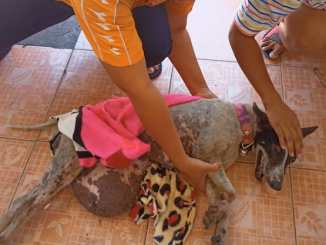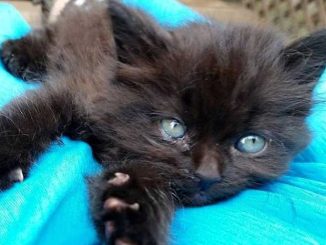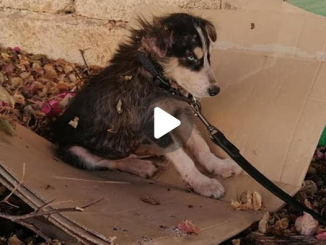Once upon a time in the picturesque village of Düzpelit, nestled in the snow-covered landscapes of Ordu, Turkey, a dedicated veterinarian named Ogün Öztürk found himself on a unique mission. He had been summoned to the village to attend to a sick cow, a task he expected to complete swiftly and return home. Little did he know that this visit would lead to an unexpected and heartwarming connection.

As Ogün wrapped up his work with the ailing cow, he noticed something out of the ordinary. Through the thick blankets of snow, he spotted a determined little girl trudging towards him, carrying a pup on her back. Their extraordinary friendship began at that very moment.

The courageous girl was none other than Cemre Su Türköz, a resident of the village. Her faithful companion, Pamuk, had been suffering from an incessant itch for several days. Worried about her furry friend’s health, Cemre was determined to find a veterinarian as soon as possible. However, heavy snowfall had cut off access to the district center, leaving her with no choice but to explore alternative options. As luck would have it, an opportunity presented itself.

That fateful day, Cemre heard that a veterinarian would be in town to tend to a cow. Fearing that the vet might leave the village before she could seek his help, Cemre Su placed Pamuk on her back and embarked on a journey of over a mile along treacherous snow-covered mountain roads to reach Ogün’s location. Her arrival took the vet completely by surprise.

The resolute young girl approached Ogün and explained her predicament – her dog’s persistent itch, the inability to reach the district center due to the snow, and her desperation to have Pamuk examined. Who could refuse such an astonishing and determined client? Without hesitation, Ogün conducted a thorough examination, and fortunately, Pamuk’s condition was not dire. A simple topical medication would suffice to alleviate his discomfort.

In awe of the 8-year-old’s courage, Ogün refused to accept any payment for his services. Cemre offered approximately 7 liras, but he kindly declined. The kindness and bravery displayed by Cemre were rewards beyond measure for the compassionate vet.

This encounter marked the beginning of a beautiful friendship. Ogün continued to visit the village, not only to check on Pamuk’s well-being but also to spend time with Cemre and her beloved dog. Through the harshest of weather conditions, Pamuk felt the love and care that the little girl had showered upon him. It was a heartwarming tale of friendship and the boundless love between a little girl and her loyal canine companion.
“This Shakes My Heart,” Bruce Willis’s Family Honors Him in a Poignant Father’s Day Tribute — Fans Are Heartbroken
The blended family of Bruce Willis, comprising his second wife, Emma Heming, his former wife, Demi Moore, and his three eldest daughters, Rumer, Scout, and Tallulah, came together to honor him with a joint Instagram post on Sunday, wishing him a Happy Father’s Day.

The heartfelt post showcased a series of 10 sweet photos, including vintage ones. It was accompanied by the caption, ’’Happy Father’s Day to our favorite girl dad. We love you, BW!’’
Two of the throwback pics showed the 69-year-old retied actor cradling his eldest child, 35-year-old Rumer, when she was a baby.

Other vintage snapshots showed Bruce holding his daughters when they were young, as well as tender moments with his younger children — Mabel Ray, 12, and Evelyn Penn, 10 — from his marriage to Emma. The post also included a touching recent photo of Scout gently touching her father’s cheek.

Fans online felt deeply moved by the touching post, and they sent their best wishes to the actor and his lovely family. One fan shared, ’’It’s a terrible illness but being surrounded by such a kind and caring family is the best anyone could hope for under the circumstances.’’ Another wrote, ’’This shakes my heart, lovely Bruce, send a lot of hugs.’’ A third simply exclaimed, ’’What a man!!’’

The father of five announced his retirement from acting in 2022 due to his battle with aphasia, a brain disorder. In February 2023, his family disclosed that Bruce had also been diagnosed with frontotemporal dementia, an irreversible condition that affects speech and motor functions.

We admire how close Bruce’s blended family is. Recently, the actor’s wife, Emma, and daughter, Tallulah, attended the “Pulp Fiction” 30th anniversary on his behalf, and it was a highly emotional moment.



Leave a Reply